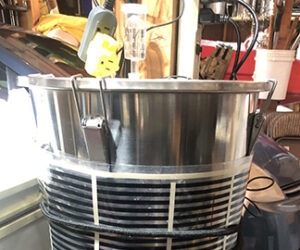Pressurizing Your Fermenter: Tips from the Pros
Brewer: Mike Gleason, Jack’s Abby Craft Lagers in Framingham, MA
There is a lot of buzz surrounding the use of a spunding valve on fermenters these days throughout the homebrewing community. Some brewers like to add it for dry hopping and carbonating purposes, while others apply them for primary fermentation. Yeast companies have even started releasing strains specifically for this purpose. So we asked three pro brewers to offer guidance on general safety and best practices when using a spunding valve on your fermenter.
First and foremost, when dealing with pressure, safety is a high priority. Always make sure you have the correct working equipment before starting by testing the valve with a keg and CO2 tank. Spunding is a great way to recapture the CO2 that the yeast provides during the fermentation process. This practice will allow you to save money and be able to tell others that you naturally carbonate your beers!
To use a spunding valve you will need to use a pressure tight vessel like a keg or pressure safe fermenter. The spunding valve will need a regulator to allow you to monitor the pressure. You should bung up (install the spunding valve) on your fermenting beer with 1 °Plato left in fermentation. For example, if your starting gravity/plato is 1.050 OG/12.5 °P, and you are aiming for a final gravity/plato of 1.010 FG/2.5 °P. Then transfer your beer into keg at approximately 1.014 SG/3.5 °P. This is just before end of fermentation and will allow you to capture CO2 without affecting the finished product. This is our technique at Jack’s Abby.
It’s very important that you know what your SG and FG are. If you bung up your beer too soon, there is potential to over carbonate or stall your fermentation. This will lead to foamy beer or you could develop some off flavors. Always monitor the beer during the fermentation process to know when it’s time to bung your beer.
Brewer: David Berg, August Schell Brewing Co. in New Ulm, MN
Obviously the first issue surrounding using a spunding valve on a vessel is that the vessel needs to be rated for pressure. And don’t tempt fate by exceeding the pressure rating provided by the manufacturer. Ideally it would be a fermenter with an additional safety valve in case the spunding valve fails. Corny kegs are the perfect vessel if there is a safety valve present on the lid. Most corny kegs come with a manual pressure relief valve that have a pull tab you can pull to release pressure. Some kegs that don’t have a manual relief valve, come with a static relief valve that will release pressure automatically if the keg becomes over-pressurized.
For homebrewers, the timing of when to bung up their fermenter is the same as that of a commercial brewery. We usually bung up 1-2 °P above terminal gravity. This allows the head pressure to build slowly.
When it comes to beer styles that may benefit from this technique we utilize — really, it’s beneficial with any style. It’s also useful if you wanted to cask condition a corny keg. Just set your spring to a lower value to get the correct carbonation. Using a carbonation chart to find proper pressure ratings at different temps is a crucial step when attempting this.
Keep in mind the solubility of carbon dioxide. If your fermenter is only rated to 14.7 psi, you’re not going to achieve full carbonation at fermentation temps. If your vessel is rated higher, you can obtain full carbonation.
Brewer: Scott Janish, Sapwood Cellars in Maryland
My initial interest in experimenting with pressure ferments stemmed from the literature suggesting that the pressure would both reduce esters and fusel alcohol concentrations — even at higher than average ale fermentation temperatures. My hope was that it would pave the way for hop aromatics to take center stage.
Intrigued by the research, I first experimented by fermenting a 5-gallon (19-L) batch in a 10-gallon (38-L) keg at a balmy 78 °F (26 °C) with RVA Manchester Ale yeast. I gave the beer 24 hours with no pressure to allow for oxygen uptake, then I hit the keg with CO2 and set my spunding valve to 20 PSI and let fermentation go. I had to release the pressure on day five to add dry hops at which point the wort was down to about 1.020. I then sealed the keg and cranked it up to 30 PSI to allow natural carbonation (.001 SG drop produces 0.5 volumes of CO2) and keep in the volatile hop compounds.
The results of the experiment were lackluster, especially compared to a non-pressurized IPA. The beer that fermented under pressure did in fact have less noticeable alcohol hotness than the non-pressurized beer and a lower ester profile that I typically get with the RVA Manchester strain, but this seemed to detract from the beer. Most importantly, the hop aroma and flavor was lacking with the pressure ferment compared to the beer that wasn’t fermented under pressure. Likely the entire matrix of beer flavors, including alcohols and esters, are just as valuable to the final product, even when trying to get hops to take the lead.
For subsequent beers, I experimented with letting fermentation go without pressure at normal ale fermentation temperatures waiting to bung up the fermenting keg until the end of fermentation, after adding dry hops. Despite heavy dry hopping, all of these beers lacked in hop aroma intensity.
As for now, I’ve stopped fermenting hop-forward beers under pressure. I still use the spunding valve after late hop additions as a means to help reduce oxygen pickup.



